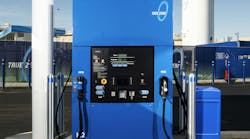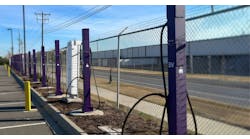How viable is hydrogen for powering the vehicles that move the economy? Some argue the zero-emission fuel source is too expensive; others believe that it will reach cost parity with diesel in a matter of years.
Regardless of its expense, companies worldwide are innovating with hopes of creating a future where hydrogen thrives as a fuel for trucks, aircraft, and even ships. FirstElement Fuel in the U.S., Bosch Rexroth, Nikola, and Hyundai are just a few of those companies working to bring hydrogen fuel to the transportation industry.
Hydrogen propulsion power has been around for decades; General Motors produced the first hydrogen fuel cell vehicle in 1966, and FleetOwner has been writing about the fuel source since the 1990s. Yet, the alternative fuel has struggled to gain traction.
Dave Hull, Bosch Rexroth’s regional VP, said he’s been a proponent of hydrogen fuel for 25 years, but “the economics never worked in the past.” Whenever gasoline and diesel prices rose, Hull said hydrogen gained traction. But once those prices fell, the buzz would soon dissipate. Today, Hull believes that “political will” and decarbonization efforts will continue to feed today’s buzz around the fuel well into its stable future.
Developing any alternative fuel production and infrastructure has its obstacles. But unlike more standardized electric vehicles, hybrids, and natural gas-powered vehicles, OEMs and developers are taking more liberties with hydrogen propulsion systems, distribution, and even production.
Consider OEMs that are developing hydrogen fuel cell vehicles versus those that are relying on hydrogen internal combustion engines, as well as the OEMs that are focusing on both propulsion systems. Then there are H2 fueling infrastructure partners that are putting their focus toward fueling with liquid hydrogen, while others are focused on gaseous hydrogen. This lack of industry cohesion—developing two types of propulsion systems and two types of fueling systems—could cause delays in hydrogen’s perceived viability for the transportation industry.
Hydrogen internal combustion engines vs. hydrogen fuel cell
Two different hydrogen-powered propulsion methods exist: hydrogen ICE and hydrogen fuel cell EV. Manufacturers such as Hyundai and Nikola have built Class 8 hydrogen fuel cell trucks with their Xcient and Tre FCEV, respectively. These trucks feature fuel cell stacks and hydrogen storage and are capable of a range between 450 and 500 miles, depending on the route and the load.
Environmentally conscious fleets operating long-haul and bulk applications that require a hefty payload might find hydrogen to be a better powertrain than pure electric vehicles. Jerome Gregeois, director of commercial vehicle development at Hyundai America Technical Center, explained it this way: "[At Hyundai], we do battery-electric vehicles, and we do hydrogen. But for an application like trucking, the weight of the energy storage system is less with hydrogen; therefore, you have more weight that you can allocate to what you're going to move.”
That weight savings also impacts range. Operators can store more energy onboard an FCEV than a Class 8 BEV, Gregeois said.
Another benefit is that, while hydrogen fueling infrastructure is still in development, refueling a hydrogen fuel cell-powered heavy-duty vehicle is quicker than fully charging a heavy-duty BEV (about 30 minutes compared to two to three hours). FCEV owners may even see that refueling time drastically improves within the coming years, as FirstElement Fuel and Bosch Rexroth have reached Class 8 hydrogen refueling in as little as 10 minutes with their jointly developed cryopump.
Finally, Gregeois said that the energy required to produce hydrogen for fuel has no impact on the electrical grid—or could even positively affect it. This is important for areas that frequently experience blackouts due to high demand on the power grid.
Other manufacturers, like engine-maker Cummins, are modifying internal combustion engines to run on hydrogen. Though Cummins is working on the development of a hydrogen fuel cell powertrain, it debuted a 15-liter hydrogen version of its fuel-agnostic X15 engine at ACT Expo two years ago. A vehicle powered by the X15H, which is testing on real routes today, was on display at the grand opening of the FirstElement Fuel hydrogen fueling station in April.
Because their operation requires the combustion of hydrogen into energy, hydrogen ICE engines have many of the same characteristics as diesel- and gasoline-powered engines, down to their rumble. Hydrogen power eliminates the particulate matter, carbon monoxide, and volatile organic compounds found in conventionally fueled engines, yet because its combustion generates heat and emits NOx into the atmosphere, hydrogen ICE vehicles aren’t considered zero-emission.
Gaseous vs. liquid hydrogen
No matter the propulsion system—hydrogen ICE or hydrogen FCEV—the vehicles need hydrogen. Hydrogen fuel is transported and stored in vehicles in two forms: liquid or gaseous, which affects fueling times.
FirstElement Fuel, one of the pioneers in the U.S. for hydrogen infrastructure, began building stations that pump gaseous hydrogen. After it received negative feedback about the time it took to fill small vehicles (20 to 45 minutes in some cases), the FirstElement team knew it had to find a different fueling method—especially when refueling heavy-duty Class 8 hydrogen FCEVs. The company found an alternative in liquid hydrogen through a technique called cyropump.
Ghassan Sleiman, FirstElement Fuel’s chief technology officer, said that, in addition to the improved user experience, the company chose to use a liquid refueling method primarily because it’s easier to deliver and provides cost advantages over gaseous hydrogen.
From a supply point of view, liquid hydrogen storage takes up about one-tenth of the footprint that gaseous storage requires. Liquid hydrogen storage tanks also require less steel than gaseous hydrogen storage tanks. This results in additional savings when considering costs for infrastructure and mass production of hydrogen fuel.
Hydrogen also takes up less space when it’s in a liquid state. Dr. Shane Stephens, FirstElement Fuel’s co-founder and chief development officer, explained it this way:
“Gaseous hydrogen is very limited in how much you can fit into a delivery trailer, and in addition to that, when you arrive at a station to offload that hydrogen, you can only offload about half of it, because it's compressed inside,” he said. “Then, as you start drawing out the hydrogen, you draw down the pressure, so you're always left with a significant amount [of hydrogen] inside.”
Because of this, more liquid hydrogen can be delivered in a single load than gaseous hydrogen. Sleiman said a fully loaded tank of liquid hydrogen delivers 4,000 kilograms compared to a comparably sized tank of gaseous hydrogen, which can only accommodate 250 kilograms. Again, this difference also contributes to cost savings; delivering more hydrogen in fewer loads is a win-win.
Developing a liquid hydrogen fueling infrastructure costs less overall because compressing liquid hydrogen takes about one-fifth the energy of compressing gaseous hydrogen, Sleiman explained. That energy to compress hydrogen also comes at a cost. In Oakland, California, where the FirstElement Fuel liquid hydrogen refueling station is located, power rates can be expensive: 20 to 30 cents per kWh, Sleiman said. This makes having lower energy consumption on-site critical.
For the consumer, truck driver, or fleet owner, liquid hydrogen even costs less on a dollar-per-kilogram basis than gaseous hydrogen, Sleiman added, even though the process of liquefying hydrogen adds costs.
“Liquefying the hydrogen product … may add $1.50 to each kilogram of hydrogen to liquefy it,” Stephens explained. “But the amount of savings that you get on distribution and on operating a cryopump as opposed to having to compress it far outweighs that extra $1 to $1.50 that you've spent on liquefying the hydrogen per kilogram.”
Is there a clear winner in hydrogen propulsion and gaseous/liquid state?
Liquid hydrogen would appear to be a natural winner in the debate against which form of hydrogen makes the most sense for hydrogen refueling infrastructure, but even the folks at FirstElement Fuel admit that it’s a bit more complicated than that.
Liquid hydrogen must be kept extremely cold, and, if kept in a tank too long, will evaporate into a gas. This process is known as boil-off. Often, boil-off is not a concern for liquid hydrogen stored in tanks that experience high turnover, such as tanks at a busy fueling station, in a long-haul truck, or even in an airplane. However, liquid hydrogen stored in tanks that take more than a few days to run through will likely experience a bit of boil-off. In these instances—such as applications like consumer vehicles, utility fleet vehicles, etc.—gaseous hydrogen would be a more efficient fuel choice.
“There are applications where gaseous trucks are better suited, and there are some situations where maybe liquid would be better suited,” Joel Ewanick, FirstElement Fuel co-founder said. “That's up to the OEM and the customer to decide where that fits.”
However, if you speak with an OEM, they might tell you something different. Gregeois said it’s entirely up to the fleet, or the customer, to decide which state of hydrogen is the best fueling option for them. Fleets must ultimately make this decision because they know their application best.
Hydrogen’s biggest obstacle is its cost
Hydrogen is the most abundant element on the planet, yet it doesn’t occur naturally. To transform it into a fuel source, it must first be extracted, the oxygen removed, and then compressed into a fuel tank. This process takes time and money.
Currently, the cost of hydrogen fuel in California is about 2.5 times that of gasoline, with one kilogram of hydrogen at $15 as of last month. But the good news is that one kilogram of hydrogen should offer more range than one gallon of gas.
“One kilogram of hydrogen gets you 1.9 times the miles of gasoline,” said Edgar Curiel with FirstElement Fuel. “In the future, the cost of hydrogen will be significantly less. For now, it's pretty expensive, but so were plasma TVs when they first came out.”
While hydrogen hopefuls are waiting for the day that production increases and hydrogen reaches the cost parity of diesel or gasoline, the federal government is pumping funds into a potential hydrogen production network.
The U.S. government recently set aside $8 billion to fund hydrogen hubs across the nation. The goal behind the project is to produce more than 3 million metric tons of hydrogen each year. Further federal investments into hydrogen include a tax credit of up to $40,000 for medium- and heavy-duty vehicles through the Inflation Reduction Act; the pursuit of clean energy technology through the Infrastructure Law and the IRA; and a $500 million investment for the Clean Hydrogen Electrolysis Program and Clean Hydrogen Manufacturing and Recycling RD&D Activities.
An article from FleetOwner published in 2022 referenced hydrogen fuel’s “steep hill to climb,” outlining infrastructure and cost as hydrogen’s main obstacles. With companies like FirstElement Fuel and Hydra Energy making hydrogen fueling infrastructure a reality and the federal government footing the bill for hydrogen production, it’s only a matter of time before the industry can reap the benefits of hydrogen fuel—that is, if hydrogen fuel is anything like plasma TVs.





